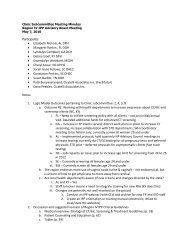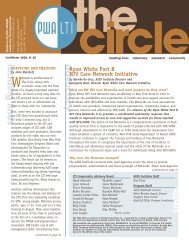Motivational Interviewing for Family Planning Providers Motivational ...
Motivational Interviewing for Family Planning Providers Motivational ...
Motivational Interviewing for Family Planning Providers Motivational ...
Create successful ePaper yourself
Turn your PDF publications into a flip-book with our unique Google optimized e-Paper software.
<strong>Motivational</strong> <strong>Interviewing</strong><br />
<strong>for</strong><br />
<strong>Family</strong> <strong>Planning</strong> <strong>Providers</strong><br />
Developed By:<br />
Disclosure<br />
•I I have no real or perceived vested<br />
interests that relate to this<br />
presentation nor do I have any<br />
relationships with pharmaceutical<br />
companies, biomedical device<br />
manufacturers, and/or other<br />
corporations whose products or<br />
services are related to pertinent<br />
therapeutic areas.<br />
To provide the underlying spirit and approach of<br />
<strong>Motivational</strong> <strong>Interviewing</strong><br />
To recognize reflective listening responses and<br />
apply them appropriately to client situations<br />
To recognize change talk and be able to evoke it<br />
using proper motivational interviewing methods<br />
To list and demonstrate several different<br />
strategies <strong>for</strong> eliciting change talk<br />
1
<strong>Motivational</strong> <strong>Interviewing</strong><br />
<strong>Motivational</strong> <strong>Interviewing</strong><br />
Introduction & Perspectives<br />
Drs. Miller, Rollnick & Moyers<br />
Overview of the Spirit of <strong>Motivational</strong><br />
<strong>Interviewing</strong><br />
Early approach:<br />
Doctor or therapist seen as<br />
expert whose task was<br />
to…<br />
<br />
<br />
<br />
<br />
educate<br />
persuade<br />
cajole<br />
confront or coerce<br />
<strong>Motivational</strong> <strong>Interviewing</strong> from the work of Miller and Rollnick<br />
MOTIVATIONAL INTERVIEWING<br />
MOTIVATIONAL INTERVIEWING<br />
Emphasis was on …<br />
conditioning<br />
medicating<br />
punishing<br />
training<br />
humiliating<br />
2
MOTIVATIONAL INTERVIEWING<br />
MOTIVATIONAL INTERVIEWING<br />
Why Use <strong>Motivational</strong> <strong>Interviewing</strong>?<br />
Intuitive<br />
Focused<br />
Helpful with difficult clients / situations<br />
Useful in short, brief encounters<br />
<strong>Motivational</strong> <strong>Interviewing</strong><br />
<strong>Motivational</strong> <strong>Interviewing</strong><br />
Central to the efficacy of MI<br />
quality of accurate empathy<br />
Blended with other interpersonal<br />
skills<br />
Characterized by<br />
collaboration rather than prescription<br />
respect <strong>for</strong> and honoring client autonomy<br />
evoking motivation rather than trying to install it<br />
<strong>Motivational</strong> <strong>Interviewing</strong><br />
<strong>Motivational</strong> <strong>Interviewing</strong><br />
Works by causing clients to<br />
verbalize their own arguments <strong>for</strong><br />
change<br />
Change Talk<br />
client expressing<br />
disadvantages of status quo<br />
advantages of changing<br />
ability to change<br />
intention to change<br />
3
Evoking Self-<strong>Motivational</strong> Statements<br />
Problem Recognition (I’ve noticed that lately…)<br />
Concern (I am beginning to feel…)<br />
Intent to Change (I am going to do something, I just<br />
don’t know what)<br />
Optimism <strong>for</strong> Change (I know I can do better or I<br />
want to do better)<br />
Change Talk<br />
Counsel in a way that invites the person to make<br />
the arguments <strong>for</strong> change<br />
Common dimensions to ask about (DARN)<br />
Desire - want, prefer, wish, etc.<br />
Ability - able, can, could, possible<br />
Reasons - specific arguments <strong>for</strong> change - Why do it?<br />
Need - important, have to, need to, matter, got to<br />
Commitment to change<br />
RATIONALE AND BASIC<br />
PRINCIPLES<br />
MOTIVATIONAL INTERVIEWING<br />
• Responsibility and capability <strong>for</strong> change<br />
lies within the client.<br />
Task to create a set of conditions that<br />
will enhance the client’s own motivation<br />
<strong>for</strong> and commitment to change.<br />
Mobilize the client’s inner resources,<br />
helping relationships, support intrinsic<br />
motivation <strong>for</strong> change<br />
4
MOTIVATIONAL INTERVIEWING<br />
MOTIVATIONAL INTERVIEWING<br />
Can be used <strong>for</strong>:<br />
Lessening resistance<br />
Resolving ambivalence<br />
Ambivalence<br />
Mixed feelings or emotions; simultaneous and<br />
contradictory attitudes or feelings<br />
Inducing change<br />
eliciting self-motivational statements<br />
What <strong>Motivational</strong><br />
<strong>Interviewing</strong> is<br />
NOT…<br />
How Do You Know When You Got It<br />
Right?<br />
Some of the key signals are:<br />
1. You are speaking slowly.<br />
2. The client is doing much more of the talking<br />
than you.<br />
3. The patient/client is actively talking about<br />
behavior change.<br />
4. You are listening very carefully and gently<br />
directing the interview at appropriate<br />
moments.<br />
5
Eight Skills in Learning<br />
<strong>Motivational</strong> <strong>Interviewing</strong><br />
1. Openness to the underlying<br />
assumptions and spirit of the method<br />
• collaborative rather than prescriptive<br />
• eliciting motivation rather than installing it<br />
• honoring client autonomy –non-confrontational<br />
2. Developing proficiency in<br />
interpersonal skills of client-centered<br />
counseling<br />
• accurate empathy<br />
• skill & com<strong>for</strong>t in <strong>for</strong>ming accurate reflections<br />
3.Recognizing “change talk”and<br />
distinguishing it from other <strong>for</strong>ms<br />
of client’s ways of speaking.<br />
4.Learning to elicit change talk<br />
(evocation) and to rein<strong>for</strong>ce it<br />
5.Learning to minimize resistance<br />
and how to respond to “sustain<br />
talk”<br />
6.Knowing when client is ready to<br />
discuss a change plan that is their<br />
own.<br />
7.Continuing to elicit client’s<br />
commitment to the change plan.<br />
8.Flexibly blending MI with other<br />
therapeutic methods.<br />
6
FOUR BASIC PRINCIPLES<br />
FOUR BASIC PRINCIPLES<br />
EXPRESS EMPATHY<br />
DEVELOP DISCREPANCY<br />
ROLL WITH RESISTANCE<br />
SUPPORT SELF-EFFICACY<br />
EXPRESS EMPATHY<br />
EXPRESS EMPATHY<br />
Acceptance facilitates change<br />
Understanding client’s feelings<br />
and perspectives without<br />
judging, criticizing, or blaming<br />
through skillful reflective<br />
listening<br />
Ambivalence is seen as a<br />
normal part of change<br />
DEVELOP the DISCREPANCY<br />
DEVELOP the DISCREPANCY<br />
The client rather than the<br />
worker should present the<br />
arguments <strong>for</strong> change<br />
Change is motivated by a perceived<br />
conflict between present behavior<br />
and important personal goals or<br />
values<br />
7
ROLL WITH RESISTANCE<br />
ROLL WITH RESISTANCE<br />
Avoid arguing <strong>for</strong> change<br />
Client Should not be directly opposed<br />
New perspectives are invited but not<br />
imposed<br />
A signal to change strategy and respond<br />
differently<br />
Includes involving the client actively in<br />
the process of problem-solving<br />
SUPPORT SELF-EFFICACY<br />
SUPPORT SELF-EFFICACY<br />
Belief in the possibility of change<br />
The client, not the worker, is responsible<br />
<strong>for</strong> choosing and carrying out change<br />
Worker’s belief in the client’s ability to<br />
change<br />
A reasonably good predictor of treatment<br />
outcomes<br />
Enhances a client’s confidence in his/her<br />
capability to cope with obstacles and to<br />
succeed in change<br />
Counselors’role is not a directive one<br />
of providing solutions, suggestions, or<br />
analysis.<br />
Instead, the counselor need only offer<br />
three critical conditions to prepare<br />
the way <strong>for</strong> natural change:<br />
Accurate empathy<br />
Non-possessive warmth<br />
Genuineness<br />
(Carl Rogers)<br />
8
Phases of<br />
<strong>Motivational</strong> <strong>Interviewing</strong><br />
Phase I<br />
Building Motivation to Change<br />
Has implications to the earlier stages of change<br />
Assessing current situation<br />
Identifying problems or issues<br />
Evoking self-motivational statements<br />
Phases of<br />
<strong>Motivational</strong> <strong>Interviewing</strong><br />
Phase II<br />
Strengthening Commitment to<br />
Change<br />
Most useful in later stages of change<br />
Increasing motivation to change<br />
Recognizing Readiness to Change<br />
Recapitulation<br />
Key Questions<br />
Traps to Avoid<br />
Phase I<br />
Question / Answer Trap<br />
Confrontation / Denial Trap<br />
Labeling Trap<br />
Expert Trap<br />
Premature Focus Trap<br />
Blaming Trap<br />
9
OPEN-ENDED QUESTIONS<br />
AFFIRMATIONS<br />
REFLECTIVE LISTENING<br />
SUMMARIZING<br />
Forms the acronym OARS<br />
<strong>Motivational</strong> <strong>Interviewing</strong> from the work of Miller and Rollnick<br />
•Repeating<br />
Stating exactly what was said<br />
•Paraphrasing<br />
Stating what was said in your own words<br />
•Reframing<br />
Early Strategies<br />
Putting an issue in a different context<br />
•Feelings (Deepest Level)<br />
Naming the emotions attached to the content<br />
<strong>Motivational</strong> <strong>Interviewing</strong> from the work of Miller and Rollnick<br />
10
OPEN-ENDED QUESTIONS<br />
•Questions that do not invite brief<br />
answers of “yes”or “no”<br />
•Used to encourage clients to talk<br />
•Client should do most of the<br />
talking<br />
•Helper listens and encourages<br />
<strong>Motivational</strong> <strong>Interviewing</strong> from the work of Miller and Rollnick<br />
AFFIRMATIONS<br />
•Another way of building rapport<br />
•Compliments or statements of<br />
appreciation and understanding<br />
•To acknowledge and affirm client’s<br />
strengths and ef<strong>for</strong>ts<br />
<strong>Motivational</strong> <strong>Interviewing</strong> from the work of Miller and Rollnick<br />
REFLECTIVE LISTENING<br />
One of the most important /<br />
challenging skills in MI<br />
Simple Reflection<br />
Amplified Reflections<br />
Double-sided Reflections<br />
<strong>Motivational</strong> <strong>Interviewing</strong> from the work of Miller and Rollnick<br />
11
SUMMARIZING<br />
•Used to link together material that has been<br />
discussed.<br />
•Should be done periodically.<br />
•Rein<strong>for</strong>ces what has been said.<br />
•Shows that you have been listening carefully.<br />
•Prepares the client to move on.<br />
•One of the more “directive”applications of MI<br />
<strong>Motivational</strong> <strong>Interviewing</strong> from the work of Miller and Rollnick<br />
COMPONENTS OF A GOOD SUMMARY<br />
STATEMENT<br />
•Restates client’s statements regarding<br />
problem recognition, concern, reasons <strong>for</strong><br />
change, and optimism about the change<br />
•Don’t ramble - be concise<br />
•End with an invitation <strong>for</strong> client to respond:<br />
How did I do?<br />
If this is a fair summary, are<br />
there other points?<br />
Is there anything you want to correct or add?<br />
<strong>Motivational</strong> <strong>Interviewing</strong> from the work of Miller and Rollnick<br />
12
Empathic Listening<br />
Using the skills of early<br />
strategies in MI<br />
Watch Your Assumptions<br />
Many behavior change consultations fail because<br />
the practitioner falls into the trap of making false<br />
assumptions.<br />
Consider these:<br />
• This person OUGHT to change.<br />
• This person WANTS to change.<br />
• This patient’s health is the prime motivating factor <strong>for</strong> him/her.<br />
• If he or she does not decide to change, the consultation has<br />
failed.<br />
• Clients are either motivated to change or not.<br />
• Now is the right time to consider change.<br />
• A tough approach is always best.<br />
• I’m the expert; he or she must follow my advice.<br />
Cash<br />
Register<br />
Activity<br />
ACTIVE LISTENING<br />
CLIENT<br />
What I say<br />
2<br />
PRACTITIONER<br />
What I hear<br />
1<br />
3<br />
What I mean<br />
or feel<br />
What I<br />
understand<br />
(Gordon 1970, Miller & Jackson 1985)<br />
13
Many statements can have multiple meanings,<br />
and your challenge is to identify one meaning<br />
that the client is trying to express<br />
“I wish I were more sociable”<br />
“I wish I were more sociable”<br />
•“I feel lonely and I want to have more friends”<br />
•“I get very nervous when I have to talk to<br />
strangers”<br />
•“I should spend more time getting to know people”<br />
•“I would like to be popular”<br />
•“I can’t think of anything to say when I’m with<br />
people”<br />
•“People don’t invite me to their parties”<br />
Active Listening Activity<br />
1<br />
2<br />
3<br />
Not Ready Unsure Ready Trying Done<br />
0 1 2 3 4 5 6 7 8 9 10<br />
Precontemplation Contemplation Preparation Action Maintenance<br />
<strong>Motivational</strong> <strong>Interviewing</strong> –Phase I<br />
<strong>Motivational</strong> <strong>Interviewing</strong> –Phase II<br />
Readiness Ruler adapted from Stoff et al 1995 & Thomas Gordon<br />
14
ASSESS IMPORTANCE,<br />
CONFIDENCE AND READINESS<br />
It seems that some people cannot<br />
change and others do not want to.<br />
Having agreed to talk about a<br />
particular behavior there are a number<br />
of directions one could take.<br />
It has been found that the assessment<br />
of “importance”and “confidence”is a<br />
useful first step.<br />
I<br />
M<br />
P<br />
O<br />
R<br />
T<br />
A<br />
N<br />
C<br />
E<br />
LOW IMPORTANCE<br />
LOW CONFIDENCE<br />
0<br />
LOW IMPORTANCE<br />
HIGH CONFIDENCE<br />
0 10<br />
HIGH IMPORTANCE<br />
LOW CONFIDENCE<br />
HIGH IMPORTANCE<br />
HIGH CONFIDENCE<br />
10<br />
C O N F I D E N C E<br />
Negotiating a Change<br />
Plan<br />
1. Setting goals<br />
2. Considering change options<br />
3. Arriving at a plan<br />
4. Eliciting commitment<br />
15








